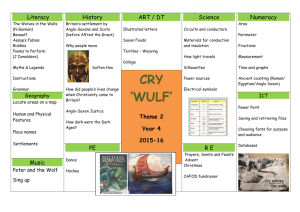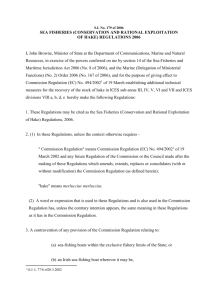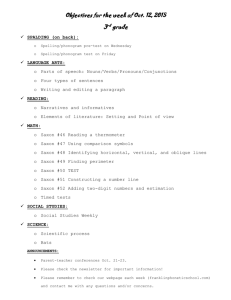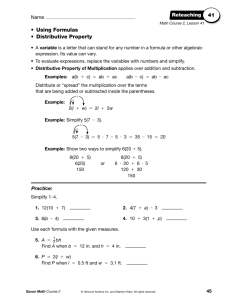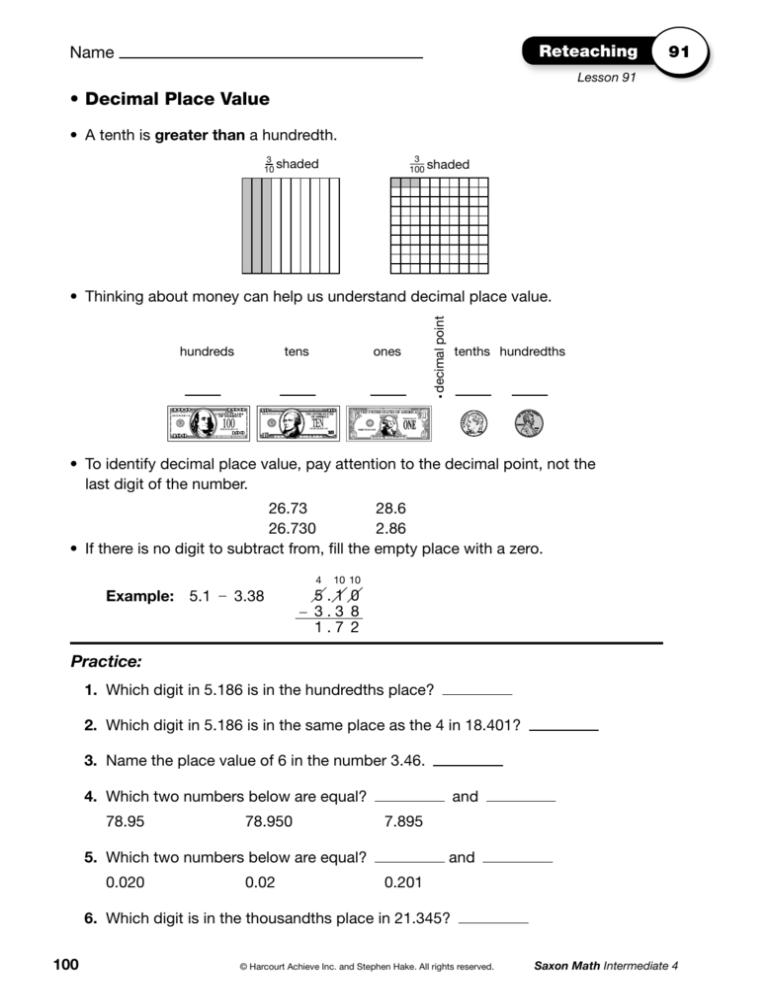
Reteaching
Name
91
Lesson 91
• Decimal Place Value
• A tenth is greater than a hundredth.
3
100 shaded
3
10 shaded
hundreds
ones
tens
decimal point
• Thinking about money can help us understand decimal place value.
tenths hundredths
• To identify decimal place value, pay attention to the decimal point, not the
last digit of the number.
26.73
28.6
26.730
2.86
• If there is no digit to subtract from, fill the empty place with a zero.
4
Example:
5.1 – 3.38
10 10
5.1 0
– 3.3 8
1.7 2
Practice:
1. Which digit in 5.186 is in the hundredths place?
2. Which digit in 5.186 is in the same place as the 4 in 18.401?
3. Name the place value of 6 in the number 3.46.
4. Which two numbers below are equal?
78.95
78.950
and
7.895
5. Which two numbers below are equal?
0.020
0.02
and
0.201
6. Which digit is in the thousandths place in 21.345?
100
© Harcourt Achieve Inc. and Stephen Hake. All rights reserved.
Saxon Math Intermediate 4
Reteaching
Name
92
Lesson 92
• Classifying Quadrilaterals
• A quadrilateral is a polygon with 4 sides.
• A parallelogram is a quadrilateral with 2 pairs of parallel sides.
• A rectangle is a parallelogram with 4 right angles.
• A square is a rectangle with 4 equal sides.
Compare quadrilaterals by studying the examples in this chart.
Classifying Quadrilaterals
A quadrilateral is any four-sided polygon.
Name
Characteristics
Trapezium
No sides parallel
Trapezoid
One pair of parallel sides
Parallelogram
Two pairs of parallel sides
Rhombus
Parallelogram with equal sides
Rectangle
Parallelogram with right angles
Square
Rectangle with equal sides
Shape
Practice:
Describe each quadrilateral as a trapezoid, trapezium, parallelogram, rhombus,
rectangle, or square. More than one description might apply to each figure.
1.
Saxon Math Intermediate 4
2.
3.
© Harcourt Achieve Inc. and Stephen Hake. All rights reserved.
101
Reteaching
Name
93
Lesson 93
• Estimating Multiplication and Division Answers
• To estimate multiplication or division answers, round first.
Examples:
45 × 31
157 ÷ 8
50 × 30 = 1500
160 ÷ 8 = 20
Practice:
Estimate each product or quotient. Then find the exact answer.
1. 48 × 22
×
Estimate:
=
4 8
×2 2
Exact answer:
+
0
2. 67 × 54
×
Estimate:
=
6 7
×5 4
Exact answer:
+
0
3. 29 × 16
×
Estimate:
=
2 9
×1 6
Exact answer:
+
0
4. 59 × 33
×
Estimate:
5 9
×3 3
Exact answer:
+
102
=
0
© Harcourt Achieve Inc. and Stephen Hake. All rights reserved.
Saxon Math Intermediate 4
Reteaching
Name
94
Lesson 94
• Two-Step Word Problems
• To solve some word problems we have to perform two operations.
• Writing down the given information or drawing a picture is often helpful in solving
two-step word problems.
Practice:
1. Christa bought 8 bagels with a $10 bill. She got back $6. What was the cost of
each bagel? Remember to write the units.
Write down what you know:
Christa bought
. She used
She got back
to pay for the bagels.
in change.
Subtract to find the cost of 8 bagels.
$10.00
– $26.00
Divide to find the cost of each bagel.
____
)
Hint: Show dollars and cents.
per bagel
2. The perimeter of this rectangle is 12 inches. The length is twice the width.
What is the area of the rectangle?
Perimeter:
Draw a picture:
Length:
Width:
Area:
3. Melissa is 15 years older than Brent. Brent is 6 years older than Gael.
If Brent is 9 years old, how old are Melissa and Gael?
Write down what you know:
Brent is
Melissa is
than Brent.
To solve,
Melissa is
Saxon Math Intermediate 4
years old.
years older
the numbers.
years old.
Brent is
which is
than Gael.
To solve,
Gael is
© Harcourt Achieve Inc. and Stephen Hake. All rights reserved.
years old,
years older
the numbers.
years old.
103
Reteaching
Name
95
Lesson 95
• Two-Step Problems about a Fraction of a Group
• Sometimes it takes two steps (operations) to find a fraction of a group when the
total is known.
• Divide by the denominator (bottom number) of the fraction to find the number in
one part.
• Multiply by the numerator (top number) of the fraction to find the number in more
than one part.
• Remember the rule we use to find a fraction of a group.
× Number in each group
× Number of groups
= Total
Example:
Solution:
At a concert, __78 of the audience wore wristbands. If there
were 5600 people in the audience, how many wore wristbands?
700
_____
8) 5600
divide the total by the denominator
700 × 7 = 4900
multiply the result by the numerator
4900 people wore wristbands.
Practice:
1. __23 of the 21 students wanted to play kickball. How many students wanted to play
kickball?
students
2. Three-fifths of the 55 beads in Ms. Cavender’s necklace were purple. How many
beads were not purple?
beads were not purple.
104
© Harcourt Achieve Inc. and Stephen Hake. All rights reserved.
Saxon Math Intermediate 4
Reteaching
Name
96
Lesson 96
• Average
To find average:
1. Add the numbers.
2. Count how many numbers were added together.
3. Divide the sum by that number.
Example:
There are four buckets of water. The first bucket has 15 pints, the second has
8 pints, the third has 9 pints, and the fourth bucket has 20 pints. What was the
average number of pints per bucket?
buckets: 1
2
3
4
15 + 8 + 9 + 20 = 52
13 pints per bucket
13
___
4) 52
Practice:
1. Jerrel has a book to read for class. He read 35 pages the first day and 75 pages
the second day. If he reads 45 pages on the third and fourth day, how many
pages does he read on average per day?
35
75
45
+ 45
____
)
pages per day
2. Anastacia plays on a basketball team. In seven games the points she scored
were 23, 42, 19, 29, 35, 48, and 7. What is Anastacia’s point average per game?
23
42
19
29
35
48
+ 7
____
)
Saxon Math Intermediate 4
points per game
© Harcourt Achieve Inc. and Stephen Hake. All rights reserved.
105
Reteaching
Name
97
Lesson 97
• Mean, Median, Mode, and Range
• The mean is the average of a list of numbers.
• The median is the middle number when the numbers are arranged in order.
If there is an even number of things in a list, the median is the average of the
two middle numbers.
• The mode is the number that repeats most in the list.
• The range is the difference between the least and the greatest numbers.
Practice:
1. Find the mean, median, mode, and range of temperatures shown below.
69°, 71°, 74°, 62°, 75°, 51°
First arrange the temperatures in order:
,
,
,
,
,
Mean (average):
Median:
Mode:
Range:
2. Find the mean, median, mode, and range of this set of data:
29, 23, 30, 32, 25, 46, 18
Arrange in order:
,
,
,
,
,
,
Mean (average):
Median:
Mode:
Range:
3. Find the median of this set of data.
78, 81, 85, 77, 83, 90
Median:
Explain your answer.
106
© Harcourt Achieve Inc. and Stephen Hake. All rights reserved.
Saxon Math Intermediate 4
Reteaching
Name
98
Lesson 98
• Geometric Solids
• Geometric shapes that take up space are called geometric solids.
• This rectangular solid is made up of 2 layers of cubes with 6 cubes in each layer
(2 × 6 = 12). The rectangular solid is made up
12
3 4
5 6
of 12 small cubes.
• Face
Flat surface of a geometric solid
• Edge
Line segment where faces meet
• Vertex
Corner where edges meet
2 layers
face
edge
vertex
Practice:
For problems 1– 4, name the shape of each object.
1. globe
2. tissue box
3. funnel
4. tuna can
5. What is the name of this solid?
6. How many edges does the figure above have?
7. Look at the figure of a rectangular solid.
How many cubes in the top layer?
How many layers?
How many cubes altogether?
8. What type of solid has 8 vertices and 6 faces?
Use the figures below to work out the answer.
Saxon Math Intermediate 4
© Harcourt Achieve Inc. and Stephen Hake. All rights reserved.
107
Reteaching
Name
99
Lesson 99
• Constructing Prisms
• A net is an arrangement of polygons (drawn on paper) that can be folded to
become the faces of a geometric solid. Picture a cereal box that has been cut
along its edges so that it can lay flat.
• We can make models of cubes, rectangular prisms, and triangular prisms by
cutting, folding and taping nets of these shapes.
Example:
The dotted lines on this net show where to fold it to
construct the 3-dimensional model. What geometric
solid does the net create?
back
front
side
side
top
bottom
If we fold the net on the dotted lines, we construct a
rectangular prism.
front
bottom
side
Practice:
1. How many faces does a triangular prism have?
2. What geometric shape is the face of a cube?
3. Are the triangular faces of a triangular prism parallel or perpendicular?
4. Look at the geometric solid below. Then sketch a net in the space at right.
108
© Harcourt Achieve Inc. and Stephen Hake. All rights reserved.
Saxon Math Intermediate 4
Reteaching
Name
100
Lesson 100
• Constructing Pyramids
• Shapes that take up space are called geometric solids. Prisms like those we
learned about in Lesson 98 are examples of geometric solids. Pyramids are
another kind of geometric solid.
• Geometric solids have three dimensions: length, width, and height.
Practice:
1. This pyramid has a square base. How many vertices does the pyramid have?
vertices
2. This pyramid has a triangular base. How many faces does the pyramid have?
faces
3. Which of these geometric solids is not a pyramid?
A
B
C
4. Look at the solid below. Then sketch a net of the solid.
Saxon Math Intermediate 4
© Harcourt Achieve Inc. and Stephen Hake. All rights reserved.
109
Reteaching Inv. 10
Name
Investigation 10
• Probability
• Probability measures how likely it is for an event to happen.
• The chance of an event is often times expressed as a percent from 0% to 100%.
• If an event is impossible, its probability is 0. Its chance is 0%.
• All other events have probabilities between 0 and 1 or chances between 0%
and 100%.
Practice:
1. What is the probability a tossed coin will land heads up?
2. What is the probability a number cube will stop on 3?
3. What is the probability a number cube will stop on a number less than 6?
4. What is the probability a number cube will stop on a number greater than 6?
5. If your team has a 30% chance of winning, is it more likely that you will win or
not win?
6. If there is an 80% chance of rain, then what is the chance that it will not rain?
Remember to write the percent symbol.
7. What is the probability that the arrow below will stop in sector A?
C
A
A
B
B
110
A
© Harcourt Achieve Inc. and Stephen Hake. All rights reserved.
Saxon Math Intermediate 4

